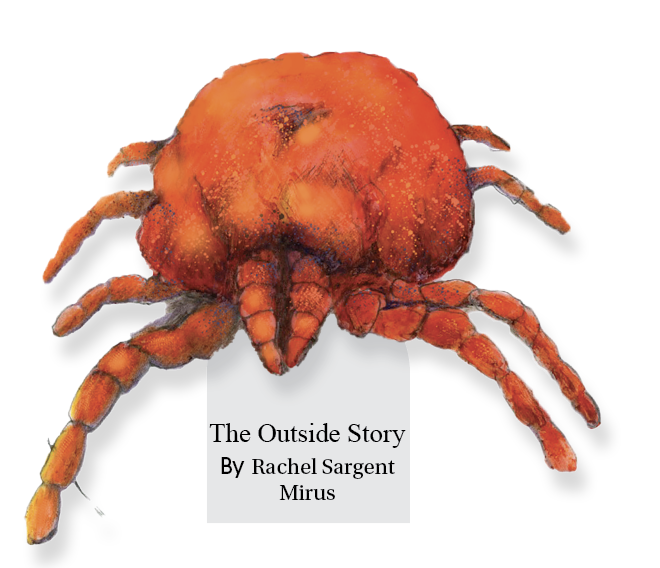 Bright red, soft, and velvety … no, I’m not describing a Valentine’s Day decoration, but a red velvet mite. Built like eight-legged, scarlet Beanie Babies, red velvet mites are hard to miss, even though most of them are no bigger than an eighth of an inch long. They are arachnids in the family Tombidiidae, so their relatives include spiders and ticks.
Bright red, soft, and velvety … no, I’m not describing a Valentine’s Day decoration, but a red velvet mite. Built like eight-legged, scarlet Beanie Babies, red velvet mites are hard to miss, even though most of them are no bigger than an eighth of an inch long. They are arachnids in the family Tombidiidae, so their relatives include spiders and ticks.
One researcher has described this diminutive arachnid as “an under-researched enigma,” and the exact number of red velvet mite species is unknown — but may be in the thousands. When I see these tiny vermilion specks, they’re most often crawling across sunny rocks as adults during summertime. But these mites have a complicated life history — including the ability, for some, to thaw out, seemingly unscathed, after freezing solid.
The life stage that’s easiest to find are the plushie-like adults, who hunt even smaller invertebrates. During the warm months, males will initiate courtship by building what one researcher dubbed a “love garden” of lollipop-shaped sperm packages, or spermatophores. To encourage female visitors, the garden-builder adds a path of delicately woven silk. (Builder beware: if another male finds the “garden” he will trash it to squash mating competition.) If a passing female is impressed, she will follow the silk trail and join in a mating dance where both mites move in circles, tapping each other with their front legs.
After a successful mating dance, the female will accept a spermatophore and lay dozens to tens of thousands of eggs in the soil, depending on her size and species. These eggs will hatch into an inactive pre-larval form, before becoming larvae that are parasites of insects or spiders. They then go through three successive nymphal stages before molting into adulthood.
In temperate regions, such as ours, these mites’ lives are further complicated by winter. Scientists once assumed that all tiny arthropods, mites included, could prevent their body fluids from turning to ice, even at subzero temperatures. Since organisms have small particles, including sugars and proteins, in their body fluids, their tissues don’t freeze at the same temperature as pure water. An animal’s metabolism, responding to seasonal signals, can adjust how many and what kinds of small particles are present in their bodies, changing the freezing point of their tissues to colder temperatures. The snow fleas that pepper the snow surface on sunny winter days use this freeze-avoidant strategy.
But some red velvet mites are untroubled by a temporary freeze. Researcher Susan Anthony, while working on her PhD thesis at Western University in Ontario, Canada, between 2016 and 2017, found active adult red velvet mites (in the genus Allothrombium) at one of her pre-snowfall winter collection locations. “I wasn’t expecting them to be freeze tolerant,” she said. She exposed the mites to low temperatures in a routine test to see how cold their bodies could get before freezing.
By putting the mites in tiny tubes and tracking their internal temperature with a thermocouple, she found that her red velvet mites would freeze at temperatures between roughly 15 and 25 degrees. “I took them out and put them on the counter,” said Anthony. “They would be curled in a fuzzy, velvet ball and I could tap them and hear ‘tic-tic-tic’.”
To her amazement, within 24 hours, all the frozen mites thawed out and began crawling around. Further testing showed that the majority of mites could survive freezing for seven days and temperatures as low as minus 4 degrees.
Red velvet mites appear to manage their freezing abilities in sync with the seasons. Anthony collected mites in the fall and housed them in outdoor containers so she could test them as the seasons progressed. She found that they were less able to survive a period of freezing in fall and spring. With the approach of warm weather, they presumably dropped their freeze-tolerance, just as mammals shed their winter coats.
And what about red velvet mites’ festive red attire? It appears to be a warning to would be predators. A few observations suggest that these mites taste really, really bad. Researchers have observed that few potential predators will eat red velvet mites; those that do eat them generally only do so once. One researcher tasted mites and wrote, “A velvet mite produced an exceedingly bitter, astringent, and spicy taste that endured in the mouth for about an hour.”
Red velvet mites may look like festive Valentine decorations, but they won’t replace your box of chocolates.
Rachel Sargent Mirus is a teaching artist and writer. Illustration by Adelaide Murphy Tyrol. The Outside Story is assigned and edited by Northern Woodlands magazine and sponsored by the Wellborn Ecology Fund of the New Hampshire Charitable Foundation: nhcf.org.



